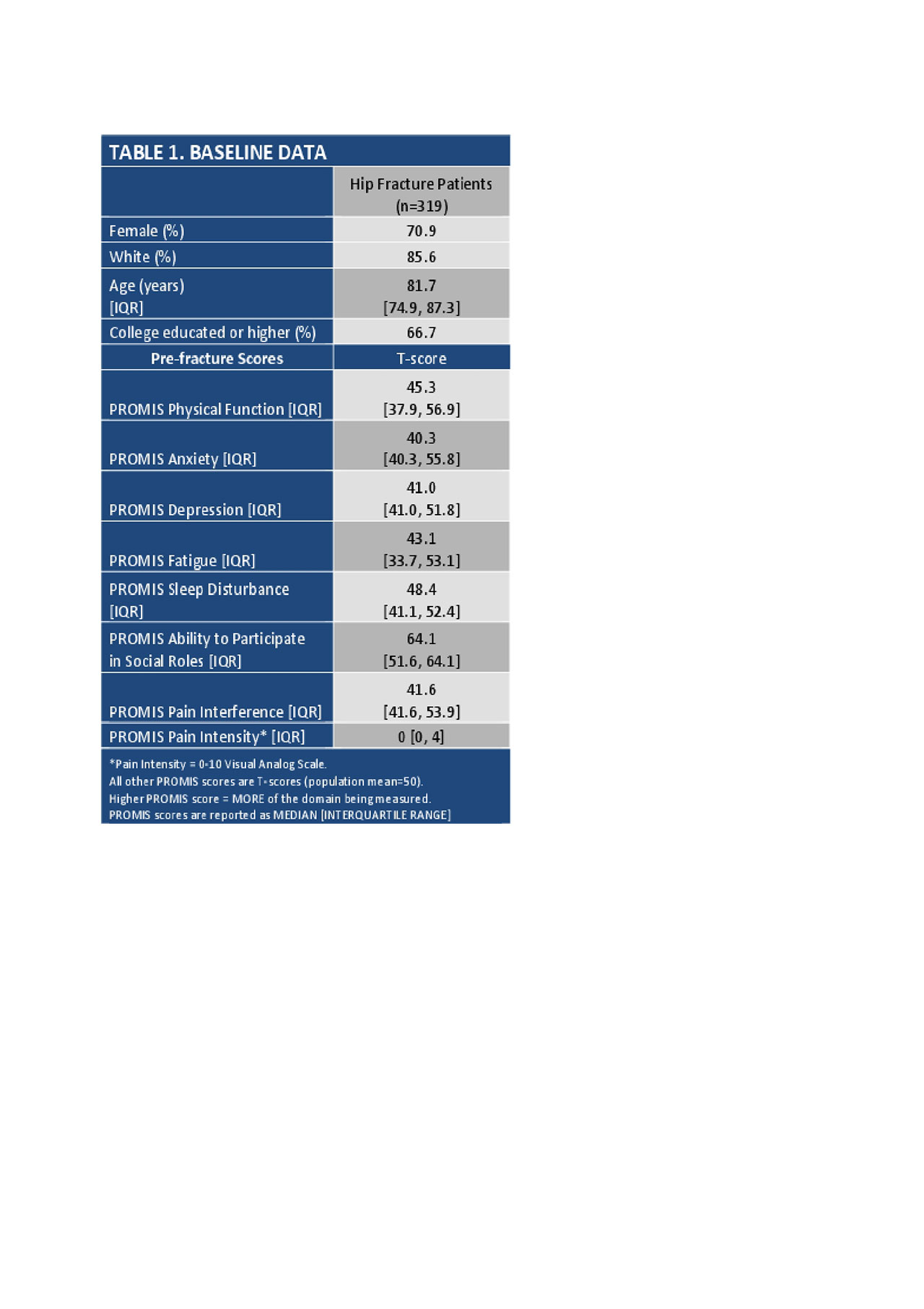Session Information
Date: Tuesday, November 12, 2019
Title: Orthopedics, Low Back Pain, & Rehabilitation Poster – ACR/ARP
Session Type: Poster Session (Tuesday)
Session Time: 9:00AM-11:00AM
Background/Purpose: Low energy hip fractures are feared harbingers of morbidity and mortality. However, many older adults are high functioning and cognitively intact at the time of fracture, and thus death or loss of health-related quality of life post-hip fracture is unexpected and particularly devastating. Whether patient reported outcome measures (PROMs), collected at time of fracture, might provide risk stratification in these patients is unknown. This study evaluates the association of pre-operative PROMs with adverse events, death, and function in a cohort of robust, cognitively intact elderly patients 1-year after surgery for a low energy hip fracture.
Methods: Patients ≥ 65 at a single center who underwent surgical repair of a low trauma hip fracture were enrolled. Patients with active cancer, dementia, previous or bilateral hip fracture, or with a non-U.S. address were excluded. American Society of Anesthesiologists (ASA) risk score was recorded. The Lubben Social Networks Scale, a validated instrument designed to measure social isolation in the elderly, PROMIS29 and the Lower Extremity Activity Scale (LEAS) were administered 2-4 days post-op. to assess pre-fracture status, and again at 1-year. Adverse events (AEs) were recorded at 30 days, 3-months, and 1-year. Multivariable exact logistic regression was used to generate odds ratios and Wald 95% confidence intervals. Multivariable linear models were specified for each PROM of interest and each outcome, adjusting for confounders identified a priori using a directed acyclic graph approach. All analyses used SAS 9.4.
Results: 956 patients were screened; 140 excluded for dementia, 85 for cancer, 66 for previous/bilateral hip fracture, 211 for other reasons, and 319 consented to enroll. Subjects had less PROMIS29 anxiety, depression, fatigue, sleep disturbance, and better ability to participate in social roles than population means, though slightly worse physical function (Table 1). 31.9% were socially isolated pre-fracture. 19 subjects died, and of 189 patients eligible for follow up, 140 (74.1%) provided 1-year data.
There was no statistically significant association between pre-fracture social isolation and any PROMIS29 domain, or cumulative AEs at 1-year. In an analysis controlling for ASA score, social isolation predicted cumulative 1-year mortality, OR 2.9 (95% CI 0.95-9.4; p=0.06); this estimate is imprecise, however, as only 19 deaths were observed. In a multivariable linear regression controlling for PROMIS29 scores, age, race, sex, and ASA score, an increase in PROMIS29 physical function (β =0.18 p< 0.001) and male sex (β =1.4 p=0.03) were associated with an increase in 1-year LEAS function.
Conclusion: Although these results are imprecise due to the small number of deaths, our observations suggest pre-fracture social isolation could be associated with an almost 3x increase in 1-year mortality in these robust, cognitively intact, elderly hip fracture patients. Further research needs to verify these estimates. Identifying actionable risk factors, such as social isolation, which can be feasibly elicited at point of care, could help direct resource-intense interventions to high priority patients.
To cite this abstract in AMA style:
Mandl L, Sheira D, Frey M, Finik J, Grueter K, Lane J. Risk Factors for Poor Outcomes After Hip Fracture Patients in the Robust Elderly: Are Patient Reported Outcomes Important? [abstract]. Arthritis Rheumatol. 2019; 71 (suppl 10). https://acrabstracts.org/abstract/risk-factors-for-poor-outcomes-after-hip-fracture-patients-in-the-robust-elderly-are-patient-reported-outcomes-important/. Accessed .« Back to 2019 ACR/ARP Annual Meeting
ACR Meeting Abstracts - https://acrabstracts.org/abstract/risk-factors-for-poor-outcomes-after-hip-fracture-patients-in-the-robust-elderly-are-patient-reported-outcomes-important/

